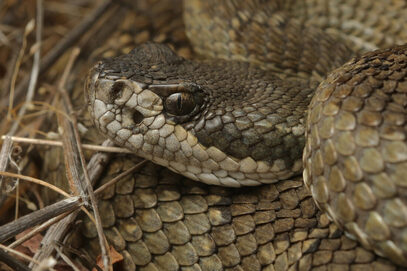 Although kids heading back to school and the calendar tells us that summer is officially winding down, encounters with snakes are not. Drought conditions, triple-digit temperatures, and other factors mean you still need to be very aware of the potential to see snakes, especially if you’re enjoying the outdoors in the late evening. Pit vipers such as Copperheads, Cottonmouths, and Rattlesnakes are not necessarily more active later in the day, you just might not see them as well now that the amount of sunlight each day is getting shorter, and the light is not as bright. When out in the evenings, carry a flashlight and watch where you put your hands and feet and watch where you sit down. Also avoid walking close to bushes or crevices with large holes. Reports of snake encounters have been particularly high in Texas and California. Texas is home to over 105 different species and subspecies of snakes; about 15 of those are potentially dangerous to humans. It seems that drought conditions, especially in the Golden State, result in an abundance of rattlesnakes. The California Fish and Wildlife Department reports that rattlers are coming up from their outback burrows and are sighted in backyards and parks much more often than ever before. Medical experts advise that if you are bitten by a snake, forget everything you learned from old Western movies— do NOT use a tourniquet, make an incision, or try to suck out the poison. A rattlesnake bite should be taken very seriously. Call 911 immediately or get to a medical facility! The faster you can get treatment, the better the outcome. The sooner you can get medical attention the sooner they can activate the system needed to get sufficient quantities of anti-venom to treat your bite. After that, the best but the hardest thing to do is try to remain calm. Avoid getting your heart rate up, which spreads the venom throughout your body faster. The same advice goes for pets if they are bitten. "The sooner the animal gets treatment, the more than likely it's going to survive," said a veterinarian in El Paso, Texas. “There is an antivenin available, but it’s extremely expensive. The effectiveness depends of the size of the dog and the amount of venom injected by the snake. A dose of antivenin for pets can cost more than $1,000." The cost of Crofab— the human antivenin— in some cases can cost more than $10,000! So no matter what the calendar might be telling us, keep in mind rattlesnakes are still in full force right now. They won’t go into hibernation in most areas for two or three more months. Whenever you’re out and about in snake country, or working in wooded areas or weeds, don't take a chance — wear snake gaiters. As with many things in life, prevention is your best bet.Comments are closed.
|
RAZER GAITERS
 RSS Feed
RSS Feed
